May 22, 2025 | 10:53 GMT +7
May 22, 2025 | 10:53 GMT +7
Hotline: 0913.378.918
May 22, 2025 | 10:53 GMT +7
Hotline: 0913.378.918
Dr. Doan Ngoc Khoi, Deputy Director of the Quang Ngai General Museum, has just discovered an area where the ancient Sa Huynh people made salt, dating back more than 2,000 years ago. This discovery is of great significance, making it an important basis for comparing the salt-making area of the Sa Huynh cultural residents with other areas around Southeast Asia and Asia in general.
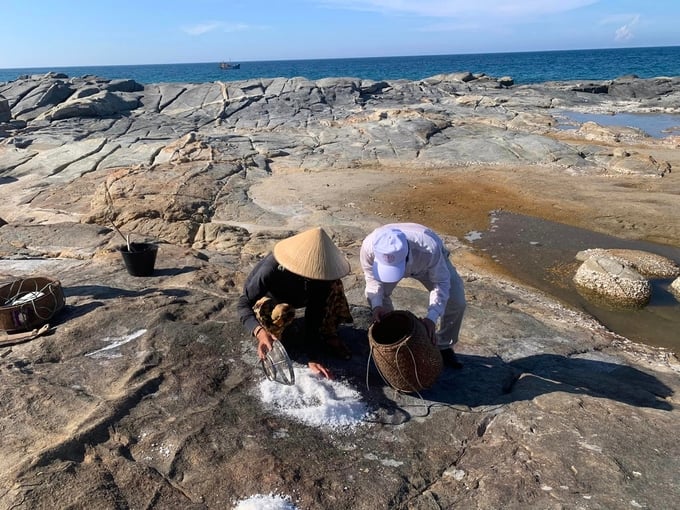
A glimpse of Trang Muoi in Sa Huynh. Photo: Vo Thanh Ky.
The land of Sa Huynh is located in the southernmost part of Quang Ngai province and is associated with a famous culture dating back approximately 3,000 years ago. There are mountains stretching out to the sea, creating a poetic scene.
Looking from the sea to the mainland, one can see majestic beaches and mountains as beautiful as paintings. Among them lies a rocky beach near the Go Co community tourism village (Pho Thanh ward, Duc Pho town), containing many interesting things. It is called Trang Muoi, nearly 10 ha wide, located between the deep green forest and the vast ocean.
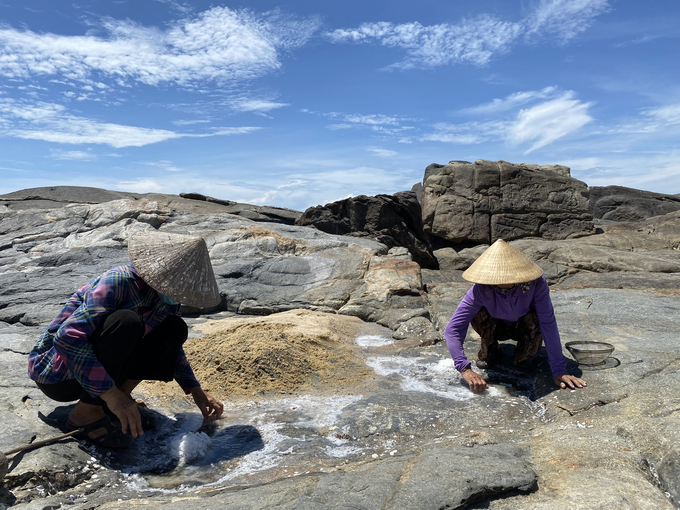
Salt workers pickle salt on rocks. Photo: Vo Thanh Ky.
The coastal sea with beautiful rocky cliffs fascinates those who come across it. These rocky cliffs are hidden in the water, running from north to south. There are many caves and holes that are the habitats and breeding grounds of many species of seafood. The fishermen here who practice diving are constantly filled with excitement, always waving their arms and legs to describe the many things they see at the bottom of the ocean. Every day they wear goggles, hold their breath with tubes and dive to the bottom to hunt for seafood.
"The coastal waters in Sa Huynh in general and Go Co village in particular have beautiful rocky reefs. The rocks are connected to each other in rows like mountains on land, stacked on top of each other to form deep caves. I often dive into the caves to find fish, squid, octopus and even small shrimp,” said Tran Van Tinh, a fisherman in Pho Chau ward, Duc Pho town.
Approaching her seventies, Bui Thi Van of the Go Co community tourism village is still quite agile. In the hot afternoon, she carries a pair of baskets and walks to Trang Muoi, hundreds of meters from her house. When she gets there, she puts down the baskets, carries a plastic bucket in her hand, and holds a shiny coconut shell to scoop water into the salt field on rocks. She carefully checks the crystallization of the salt and then looks up at the clouds rising on the horizon, signaling an approaching storm.
Her face shows a worried expression. She gives out a soft sigh and walks to the next salt field, which has crystallized like a white lotus blooming on the gray-brown stone. Van squats on the rock and reaches out to touch the salt that has crystallized after days under the blazing sunlight. She holds the white salt grains with great care, just like her ancestors once did.
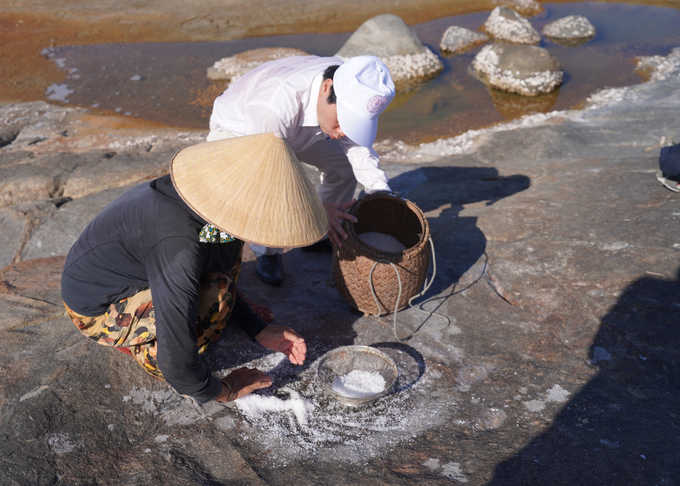
Harvesting salt on the rocky beach. Photo: Vo Thanh Ky.
Trang Muoi has two areas: a large seawater reservoir and a salt field on rocks. High tides and crashing waves bring water into the reservoir. The water is exposed to the sun, making it saltier than usual. The residents of Go Co village scoop this water into the second sun-exposed pool. Then, they scoop the water from the pool into clean cloth bags before pouring it into the salt fields.
Every day, the salt workers add seawater to the fields to increase the thickness of the salt. The salt fields are hollows, or rocky foundations lined with clay. They bring clay from the edge of the village to Trang Muoi, knead it with seawater, and then line the banks to form small salt fields. The first batch of salt crystallizes after a whole week of “sunbathing”. Since the salinity increases, the next time, after only three sunny days, the salt becomes extremely eye-catching pure white grains.
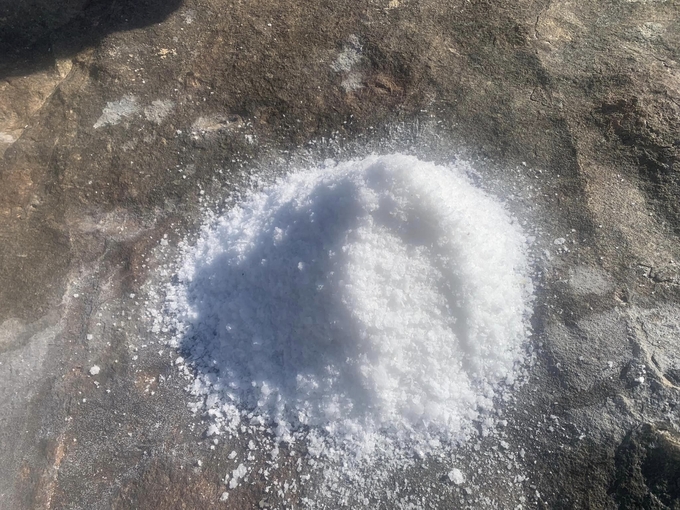
Salt produced on rocks is of excellent quality, a very unique feature in Sa Huynh. Photo: Vo Thanh Ky.
The salt grains here are much larger than those in other places, salty but not too strong, and are perfect for seasoning food. Many people prefer to use this type of salt to pickle fish and blanch fish before shipping them to distant areas to sell. Anchovies, mackerel, and tuna intestines combined with the salt here produce batches of delicious fish sauce.
"Making salt on rocks is not very productive, but the quality is out of the question. It is usually saved for family use, for salting or blanching fish. We only sell to customers if there is salt left to spare. Many people buy at a price of VND 30,000/kg, but sometimes there is not enough salt to sell,” Van said.
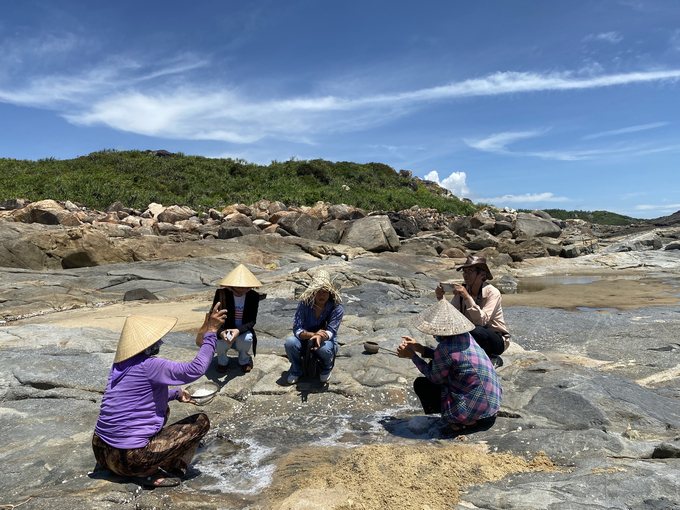
Dr. Doan Ngoc Khoi (far right) surveys Trang Muoi. Photo: Vo Thanh Ky.
Dr. Doan Ngoc Khoi, who has many years of research on Sa Huynh Culture, was excited when he discovered the "blooming rock area" that the locals called Trang Muoi. For generations, the people of Go Co had diligently made salt on the rock field next to the village. They felt elated to find out that the salt production profession had actually existed for thousands of years, as it helped to clarify the mysteries of the ancients.
Most of the salt fields have the characteristic of chloride penetrating over a long period of time into the rock crust, causing the rocks to erode and become dark black, containing many mysteries of old age. After many days of research, Dr. Khoi believes that the salt production profession on the rocks here dates back more than 2,000 years ago. The tradition perseveres, lasting from the ancient Sa Huynh residents to the Cham Pa and Dai Viet people. This is considered an important discovery, contributing to clarifying the salt production techniques of prehistoric people.

Sa Huynh salt clinging to rocks looks beautiful. Photo: Vo Thanh Ky.
Researchers are currently collecting more samples of artifacts to use laboratory analysis methods and determine the exact age of the salt-making industry in this land. They aim to analyze samples of clams collected at Trang Muoi or conduct petrographic analysis to understand the structure of the salt field surface and the erosion of the rocks. In addition, studying the chemical composition of the salt on the rocks will also provide useful information about the elements contained in the salt.
Translated by Samuel Pham
![Reducing emissions from rice fields: [3] New values generated from carbon credit](https://t.ex-cdn.com/nongnghiepmoitruong.vn/608w/files/content/2025/05/19/dsc09613-144700_71-150957.jpg)
(VAN) In addition to helping safeguard the environment, the low-emission rice cultivation model also generates new opportunities for farmers by leveraging the carbon credit market.
![Ho Chi Minh city adapts to climate change: [1] Vulnerable in the whirlwind of development](https://t.ex-cdn.com/nongnghiepmoitruong.vn/608w/files/duyenht92/2025/05/19/3131-ngap-nongnghiep-163121.jpg)
(VAN) As the country's economic engine with a rapid urbanization rate, Ho Chi Minh city is facing increasingly serious consequences of climate change.

(VAN) On May 21, Minister of Agriculture and Environment Do Duc Duy worked with Mr. Olivier Brochet, Ambassador Extraordinary and Plenipotentiary of the French Republic to Vietnam.

(VAN) VRG recently conducted a visit and working trip to the United States to demonstrate its efforts in redefining the role of rubber enterprises in the global value chain.

(VAN) In 2024, over 295 million people across 53 countries and territories faced acute hunger—an increase of almost 14 million people compared to 2023, while the number of people facing catastrophic levels of hunger reached a record high.

(VAN) World Environment Day 2025 (June 5) carries the theme 'Beat Plastic Pollution' continuing to emphasize the global urgency of addressing the plastic waste crisis.

(VAN) This was the assessment shared by experts at the workshop titled 'Assessing the Role and Potential of Low-Emission Rice Production Systems in Vietnam,' held on the morning of May 19.